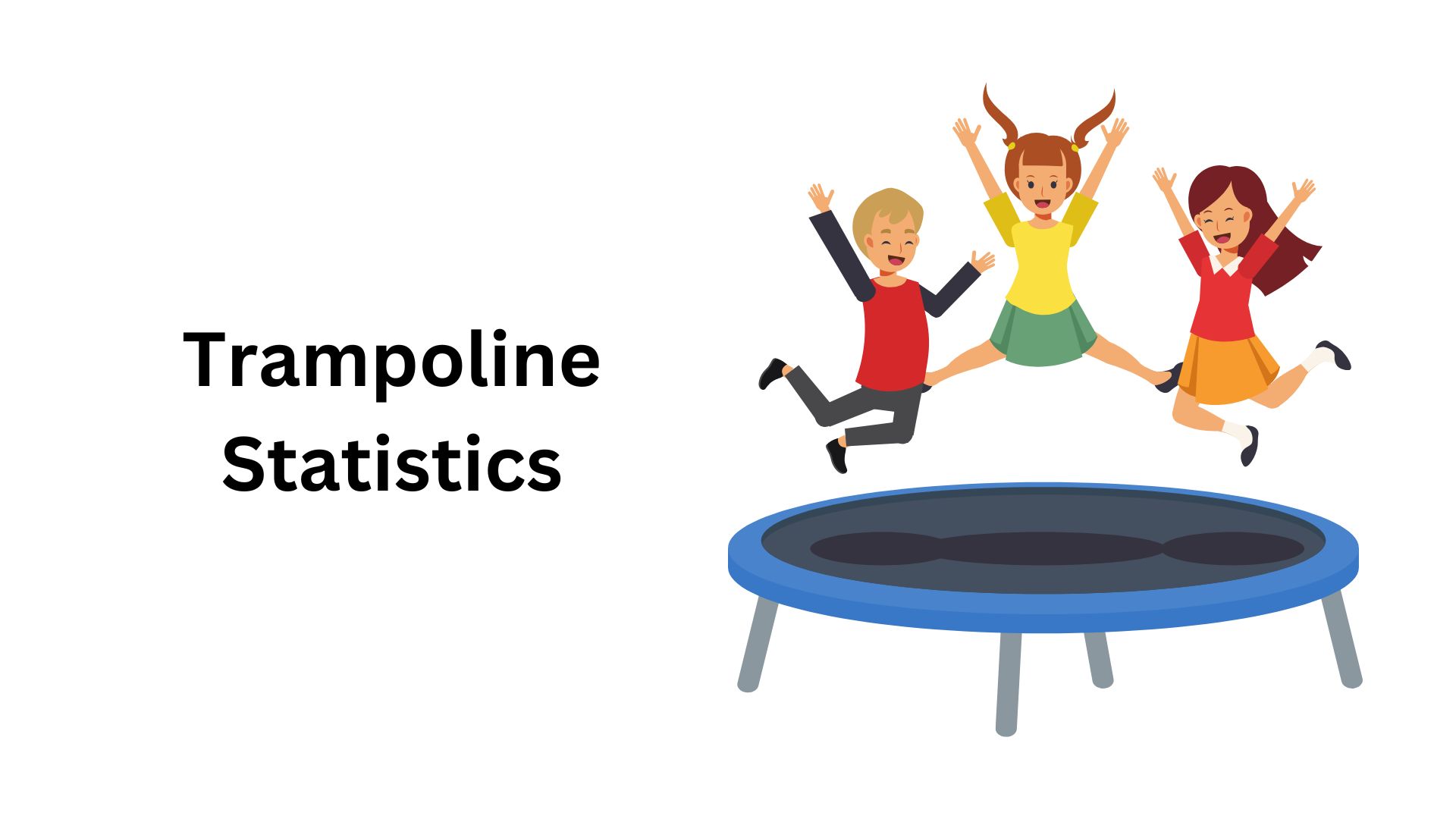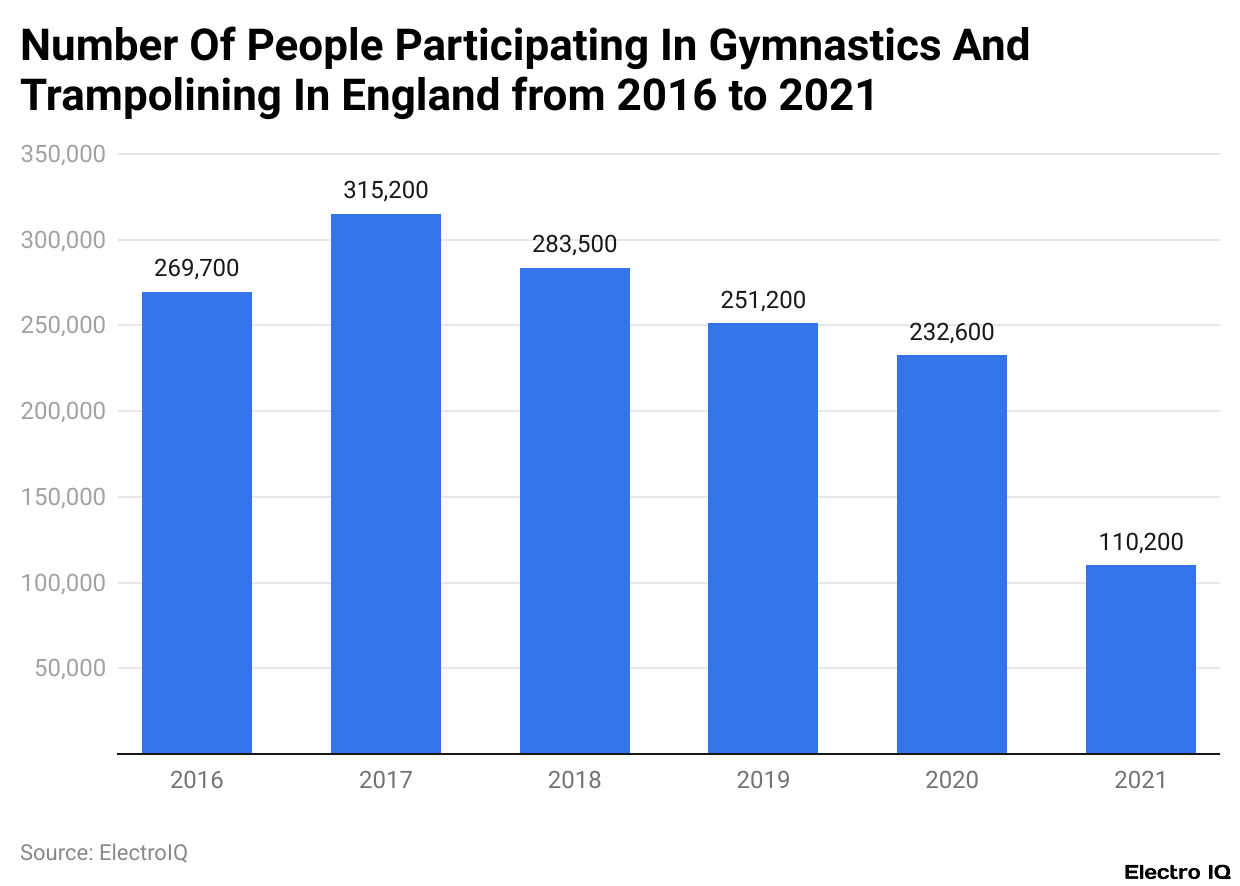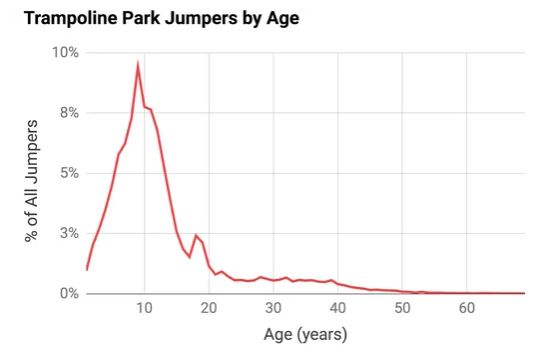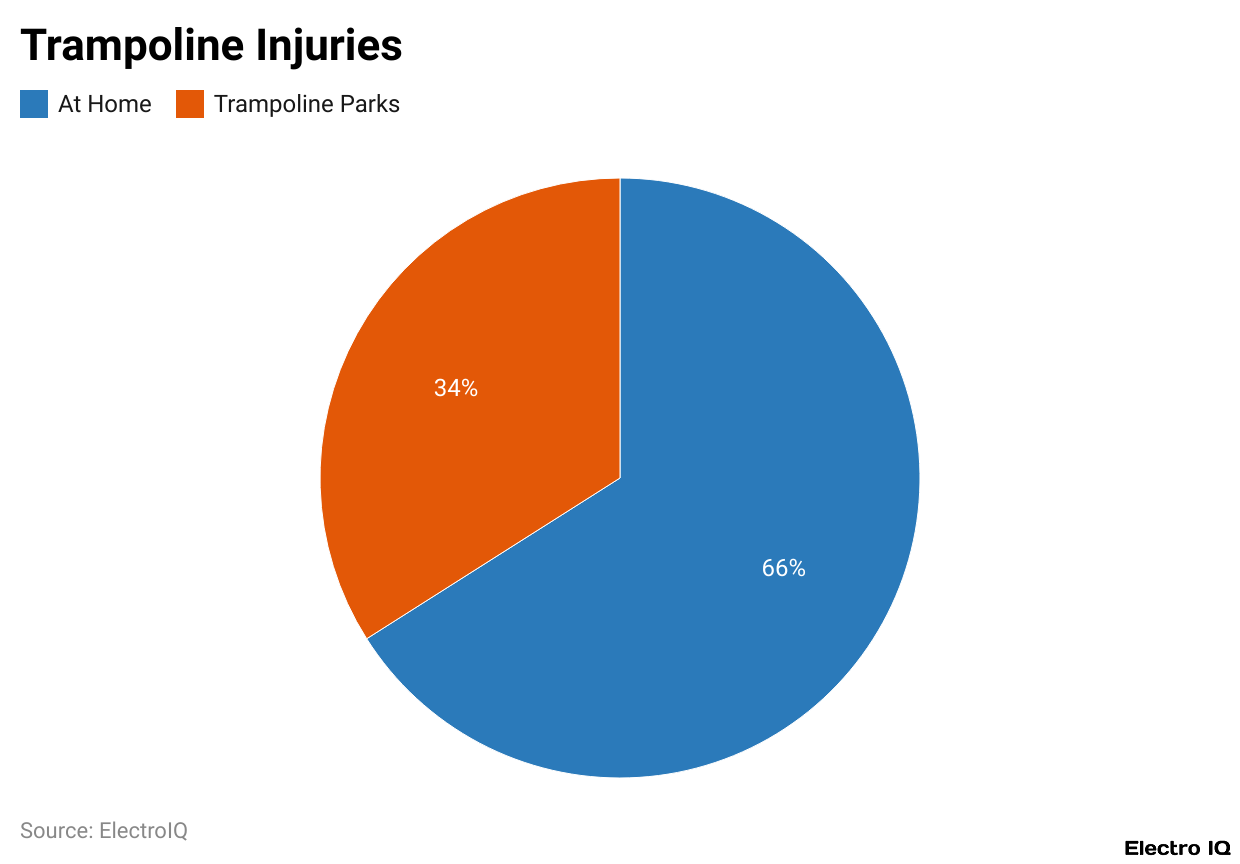Trampoline Statistics By Market Size, Olympic, Injuries And Demographics
Updated · Jul 02, 2025

Table of Contents
Introduction
Trampoline Statistics: Whether small or big, trampolines have become a prop for both kids and adults to jump up and down for fun. Trampolining could be as easy as setting up a trampoline in a backyard and performing aerial maneuvers or a big trampoline park; whatever the case, trampoline jumping is fun and good exercise. However, this high use increases injuries that are related to trampoline usage.
Trampoline statistics about injury should make it easy for users, parents, and investors in the industry to adopt safer practices and hence cut down on injury experiences.
Editor’s Choice
- According to Trampoline statistics, The trampoline market has increased at the compound rate of 4.62% from US$2.50 billion in 2017 to US$3.28 billion in 2023 and is likely to reach around US$5.15 billion by 2033.
- Gymnastics and trampolining saw a peak of about 315,200 participants in 2017, and since then, there has been a sharp decline down to around 110,200 members in 2021, possibly due to the COVID-19 pandemic.
- Trampoline parks are crowded with adults in their 20s and 30s, with children accounting for more of the trampoline jumpers.
- Trampoline statistics state that of the jumpers, kids aged between 6 and 10 years are 35%, 26-11 to 15 years, and 13% are babies aged between 0 to 5 years.
- In 2024-PARIS, Ivan Litvinovich stood by his 2021 title, while Bryony Page (Great Britain) won women’s gold.
- It was established that 66% of trampoline-related injuries occur at trampoline parks, while 34% happen at home.
- The average jumper in trampoline parks is a 9-year-old, with 35% aged between 6 and 10 years, 26% aged between 11 and 15 years, and 15% being adults in their 20s and 30s.
- Future developments in trampoline gymnastics show an active participation of 2471, including 738 senior males and 685 senior females.
- Trampoline statistics reveal that in 2023, Vuly Trampolines also bought Springfree Trampolines for US$50 million.
- Plum Products and Jumpking combined in early 2024 to reach a valuation of US$80 million.
- Skywalker Trampolines released their AI-enabled Smart Trampoline in 2023 to track safety and performance.
- Springfree Trampolines raised US$25 million to develop high-tech safety features in advanced materials and sensors.
- Acon raised US$15 million for the manufacture and development of Mars eco-friendly trampolines.
- By 2025, 20% of the projected installed base of trampolines is likely to incorporate jump tracking and safety monitoring features.
- Trampoline statistics indicate that by 2026, about 30% of trampolines are expected to be made out of eco-friendly or recyclable materials.
Trampoline Market Size

(Reference: news.market.us)
- Over the global trampoline market from the year 2017 to 2033, there has been constant growth with a CAGR of about 4.62% across the years.
- Trampoline statistics reveal that the market was initially valued at US$2.50 billion in the year 2017 and increased to a value of US$2.62 billion by the following year, 2018.
- The upward trend continued and reached US$2.74 billion in 2019 and US$2.86 billion in 2020. The market value in 2021 increased to US$3.00 billion and then further increased to US$3.13 billion in 2022 and US$3.28 billion in 2023.
- Such a trend in growth is projected to continue, while it is anticipated that the market size will be around US$3.43 billion in 2024, US$3.59 billion in 2025, and US$3.75 billion in 2026.
- By 2027, the market is expected to grow to US$3.93 billion and reach US$4.11 billion by 2028.
- The market is forecast to reach US$4.30 billion in 2029, and it is estimated to reach US$4.50 billion at the end of the year 2030.
- The upward trend is likely to continue, and expected market sizes will be US$4.70 billion in 2031, US$4.92 billion in 2032, and eventually US$5.15 billion by 2033.
Gymnastics And Trampolining Participation
 (Reference: statista.com)
(Reference: statista.com)
- Trampoline statistics explain the number of participants in gymnastics and trampolining from 2016 to 2021 and point to variations in participation over the years.
- In the number of participants, 269,700 appeared in 2016, after which there was a considerable rise to 315,200 in 2017; the trend peaked during that time.
- Then comes 283,500, which marks participation as falling in 2018 and decreased further to 251,200 in the following year. It was a declining count going into 2020, with participation at 232,600.
- Thus, the most drastic decline would happen in 2021 when the number of participants sharply declined to 110,200.
- This considerable reduction might have been caused by something outside itself, for example, the closure of sports facilities and reduced opportunities for training access during the COVID-19 pandemic.
- This suggests that, after peak participation in 2017, participation fell consistently and had a steep fall in 2021.
Trampoline Jumpers By Age

(Source: akrobat.com)
- Trampoline parks are increasingly popular among people in their twenties and thirties. More of them take the activity within this age range, indicating that older age groups also try to keep up with trends in trampolining.
- Children, however, make up most jumpers. Kids between six and ten years account for 35% of all jumpers.
- Those aged 11-15 contribute 26%, while toddlers amount to 13%. Adults are not as favored in jumping or doing fun as it may seem.
Trampoline Olympic Statistics
London 2012
- The trampoline gold medalists in Beijing could not reproduce their winning act in London. In the women’s final, the reigning Olympic champion, He Wenna of Chin, stumbled at the end of her routine and had to make do with a medal of bronze.
- Trampoline statistics reveal that Canada’s Rosie MacLennan gave a personal best score of 57.305 to claim gold, the first for Canada in the London Games.
- It was also a remarkable achievement for the United States because Savannah Vinsant had emerged as the first American athlete to reach the Olympic trampoline final since its introduction in 2000.
- On the men’s side, Lu Chunlong from China, who had won gold for his country in the 2008 Olympics, was outdone by his compatriot Dong Dong, who dominated the qualification round and saw himself ahead of the Russian silver medalist, Dmitry Ushakov, by over a point.
- However, the performance of Team USA was not one of the best ones, as Steven Gluckstein finished dead last in the qualification round after crashing on the safeties with an incomplete routine.
Rio 2016
- In the men’s trampoline event, Belarus celebrated its first-ever Olympic gold in the sport as Uladzislau Hancharou scored an eye-popping 61.745 on his Olympic debut.
- In 2012, Dong Dong from Chin, a gold medalist, settled for silver while his compatriot took bronze.
- In the women’s event, the 56.465 set by Canada’s Rosie MacLennan in defense of her Olympic title marked her as the first to achieve back-to-back golds in a trampoline competition.
- Silver went to Great Britain’s Bryony Page, while China's current world champion, Li Dan, settled for bronze.
Tokyo 2020
- One of the popular medal contenders ahead of the Tokyo Games was Rosie MacLennan, a two-time Olympian, but she was ultimately outdone by Zhu Xueying of China, who scored 56.635 to take gold and end MacLennan’s streak.
- Liu Lingling of China was just behind her compatriot to win silver. Yet again, it is two from China up on the Olympic podium. Bryony Page of Great Britain took bronze with 55.735, adding to her silver from Rio.
- Team USA’s strong showing in the event came from Nicole Ahsinger, who finished a fine sixth, matching the best-ever finish by a USA woman in the Olympics in trampoline, formerly set by Savannah Vinsant in 2012.
- Belarus was still outshining in trampoline this time as Ivan Litvinovich, who was 20 years old, earned gold in this category.
- He executed the most difficult routine among the finalists but performed it flawlessly to beat China’s Dong Dong narrowly. New Zealand’s Dylan Schmidt secured bronze with a score of 60.675 for the first-ever Olympic medal for his country in any gymnastics discipline.
Paris 2024
- Belarus’s Ivan Litvinovich, competing as an Individual Neutral Athlete at the Paris Olympics, defended his Tokyo Olympic title by becoming the first male trampolinist to win gold medals in two Olympic events.
- China delivered a strong performance, with Wang Zisai winning silver owing to his high execution score and Yan Langyu winning bronze.
- However, American competitor Aliaksei Shostak fell during qualifications and, once again, did not make the finals. On the women’s side, Bryony Page from Great Britain turned Olympic gold medalist at 33 years of age to complete her medal collection.
- Viyaleta Bardzilouskaya of Belarus, also an Individual Neutral Athlete, captured silver in her first Olympics, and bronze went to Canada’s Sophiane Methot after edging through to the final round.
- Defending champion Zhu Xueying of China ended with a poorly executed, off-center landing, just shy of the podium in fourth place, a first since 2000 when no Chinese athlete found its way onto the Olympic trampoline podium.
- For the United States, Jessica Stevens, despite being a clear star of the 2023 World Championships, finished 13th in qualifications, failing to make the final.
Trampoline Injuries Statistics
 (Reference: lezdotechmed.com)
(Reference: lezdotechmed.com)
- Trampoline statistics show that Trampoline-related injuries happen at home and even in trampoline parks, but most of them happen in dedicated trampoline facilities.
- Trampoline parks have been associated with 66% of all the reported injuries. Thus, the most common location where such accidents happen is at trampoline parks.
- At these facilities, multi-user bounce activity transpires on bigger jumps and interconnected jumping surfaces, risking them even more to possible collisions, landings awkwardly, or falling.
- The high-energy space, together with all those fancy tricks and competitive play, remarkably increases the risks for more serious injuries.
- In contrast, 34 % of trampoline injuries occur at home in a backyard or private places as a setting for these trampolines. Most home trampoline accidents happen with fewer people involved but are still due to poor supervision, lack of safety net, or risky stunting.
- The most common types of injuries at home include falling off the trampoline, bumps, and crashes with other people, and landing badly after a jump or flip.
- The great divide in injury prevalence between trampoline parks and home trampolines, for example, shows the consequence of crowding and the kind of activities done at trampoline parks.
Trampoline Demographics
- A three-month, large-scale study among fifty trampoline parks was held from April to June 2019 to capture the trends specifically relating to the participating demographic of people jumping at those parks.
- Nine years became the single most common age for step jumpers. Trampoline statistics further revealed that children aged between six and ten form the largest category, comprising 35% of the total jumpers.
- This was followed by teenagers aged between 11 and 15 years, who came in second rank, constituting 26% of the jumpers. Toddlers from one to five years also were 13% of participants at trampoline parks.
- There was a significant rise in trampoline usage among adults aged largely in their twenties and thirties, making up 15% of all trampoline users. The above-mentioned facts prove the age diversification among trampoline users in the parks.
- Further description of the competitions by age and other disciplines illustrates more results regarding how the number of total participants is divided across genders.
- Thus, active male gymnasts tally up to a total of 1,611, consisting of a combined 1,177 senior men and 434 junior participants in Men’s Artistic Gymnastics.
- There were no senior men in Women’s Artistic Gymnastics; however, there were 1,117 senior women and 582 junior participants, resulting in 1,699 active female gymnasts.
- There were a total of 2,256 participants in Rhythmic Gymnastics, which only pertains to women: 1,201 in the senior category and 1,055 in the juniors.
- The number of 2,471 active participants consisted of Trampoline Gymnastics, which consisted of 738 senior men and 685 senior women, along with 450 younger men and 598 younger women.
- Acrobatic Gymnastics accounted for 287 senior men along with 558 senior women; there were 64 additional younger men and 290 additional younger women for a total of 1,199 athletes.
- Trampoline statistics state that the total of active participants in Aerobic Gymnastics from the categories mentioned is 2,120, summing up 224 senior men, 502 senior women, 146 younger males, and 1,248 younger females.
- The least Parkour category contained 227 participants consisting of 176 men and 51 women aged 18 years and older.
- The overall number of active athletes in gymnastics is 11,583. They include a total of 2,602 senior men and 4,114 senior women, while younger participants have 1,094 men and 3,773 women.
Recent Developments
- In Australia, Vuly Trampolines is a manufacturer of trampolines, and Springfree Trampolines is considered one of its rivals for being most known for its brand of innovation of a very spring-less design.
- In this case, the acquisition took place at a premium price of US$50 million to broaden the product range and up the level of Vuly’s participation in the global market.
- Trampoline statistics show that in early 2024, Plum Products, a company based in the UK and focused on outdoor play equipment, merged with the U.S. company Jumpking.
- This is an agreement worth US$80 million, the same that anticipates a boost for both companies as far as their position in the trade of trampolines and outdoor games within Europe and North America is concerned.
- Alexis de Vos, reporting on other influences about the growth of new products in 2023, has it that, Just recently, Skywalker Trampolines unveiled a new Smart Trampoline that had inbuilt AI technology.
- The sensor device tracks any jumps, while the software keeps track of safety and provides real-time status on progress through a mobile app. The trampoline is engineered for maximum enjoyment and greater safety while using it.
- Almost simultaneously, Vuly Trampolines issued the 360 Pro Trampoline, an enclosed model having an in-built basketball hoop and a swing that rotates-the design is intended for users with all kinds of recreational activities, as well as fitness enthusiasts looking for a more varied and tough setup.
- Trampoline statistics indicate that Springfree Trampolines secured funding of US$25 million in 2023 to develop safety technology for trampolines, especially focused on the new materials and sensor-based innovations that promise to cut injury risks for children and adults even further.
- Likewise, Finnish-based trampoline manufacturer Acon financed US$15 million in late 2023 to enhance production capacity to serve the growing need across Europe and North America among users.
- It is estimated that by 2025, 20% of trampolines will come with smart features, such as integrated sensors that measure performance, calculate the number of jumps, and add safety for use.
- By 2026, about 30% of all trampolines should provide materials that are either eco-friendly or recyclable, thus demonstrating how the industry is shifting toward greener manufacturing.
Conclusion
As pet trampoline statistics, everyone knows that trampolines can be fun to exercise, but it is important to remember that they also come with risks. Understanding injuries and implementing the safety measures recommended can help reduce the risk of injuries by significant margins. A safe trampoline would be fun for all but, at the same time, not safe.
FAQ.
Initially pegged at US$2.50 billion in 2017, the global trampoline market has shown steady growth up to the latest figure of US$3.28 billion in 2023, thus projecting a market size of US$5.15 billion by 2033. This growth has been due to increasing participation, the introduction of new products, and the growing popularity of trampoline parks.
Approximately 66% of injuries caused by the use of admission-based kind of equipment are sustained in trampoline parks where multiple jumpers and high-energy environments increase the odds of collision, awkward landings, and falls. The remaining 34% are experienced at home, most often due to improper supervision, unsafe features, or risky stunts.
Users of trampoline parks are categorised into three groups according to their ages. Still, kids form a sizable proportion, with 35% in the 6-10 age bracket, while 26% of users are between the ages of 11-15. Another 13% are toddlers. However, participation levels among adults in their 20s and early 30s are on the rise, currently making up 15% of all jumpers.
Smart trampolines are among the recently developing technologies equipped with AI sensors for safety and performance monitoring. These include models recently launched by Skywalker Trampolines and Vuly Trampolines, which feature innovations like real-time jump monitoring, an enclosed design, and an integrated basketball hoop. By 2025, it is estimated that 20% of trampolines will have smart features, while by 2026, 30% will be produced from eco-friendly materials.
In 2023, Vuly Trampolines acquired Springfree Trampolines, which was worth US$50 million, to extend its presence in the market. In January 2024, Plum Products merged with Jumpking in a US$80 million deal. Also, Springfree raised US$25 million for new safety innovations, while Acon climbed US$15 million to make production green.

Joseph D'Souza founded ElectroIQ in 2010 as a personal project to share his insights and experiences with tech gadgets. Over time, it has grown into a well-regarded tech blog, known for its in-depth technology trends, smartphone reviews and app-related statistics.










